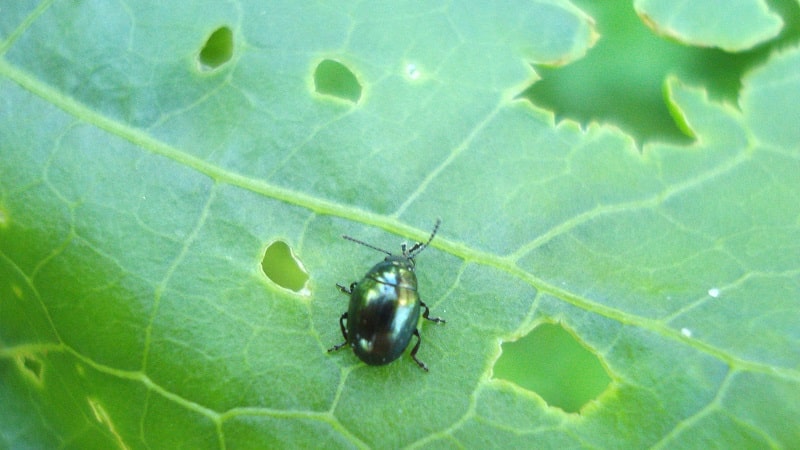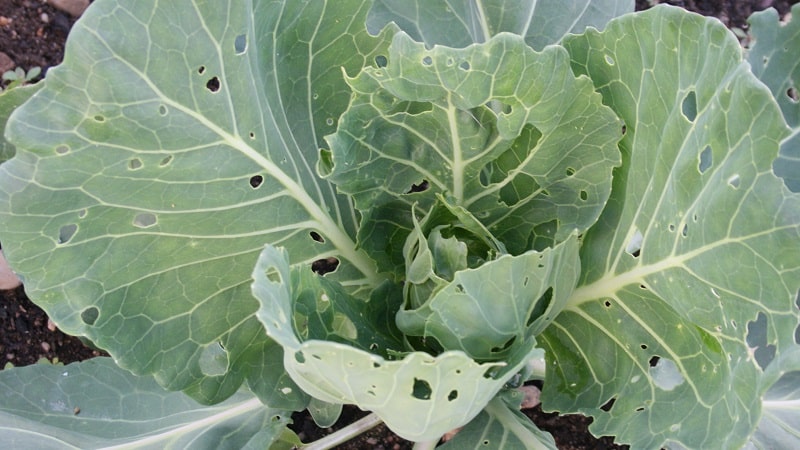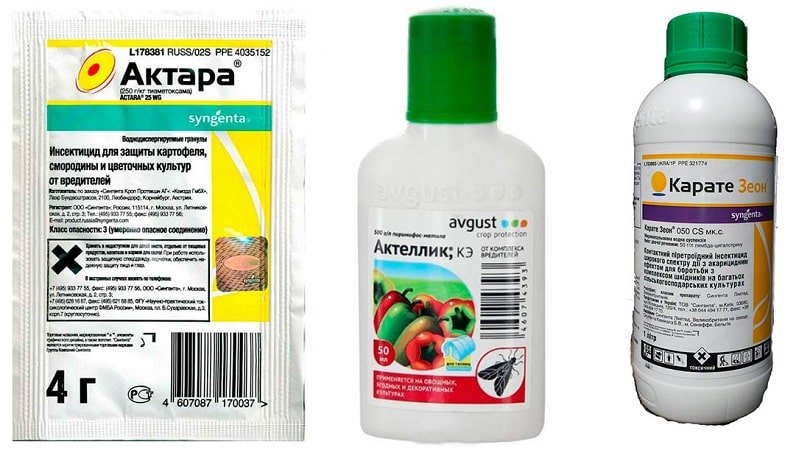How to deal with fleas on cabbage
If holes with jagged edges appear on cabbage leaves, this is a clear sign of a cruciferous flea attack. The insect is often found in the beds of this vegetable crop, as it feeds on the sap of the plant. To save the crop, there are many ways to destroy the pest - chemical, biological and folk remedies. For more information on how to treat cabbage if black flea beetles are eating it, read the article.
How and why fleas appear on cabbage
Tiny black beetles are called flea beetles because of their jumping ability. This method of movement allows them to quickly spread throughout cabbage plantings and wreak havoc over very large areas.
Insects prefer to feed on all plants from the cruciferous family: with the arrival of spring, on young weeds, then they switch to vegetable seedlings.

Pests cause especially great damage to cabbage beds when in the barely emerging leaves of young seedlings they eat away many rounded holes, damaging the growth points of seedlings.
Cruciferous fleas are distributed throughout almost the entire territory of Russia. Their massive invasion occurs at the end of April - beginning of May. Until this moment, leaf beetles hibernate in the top layer of soil or under fallen leaves.
As soon as the air warms up to +15°C, they come out of their shelters and pounce on the tender leaves of growing cabbage seedlings or shoots. Actively and quickly reproducing, they are capable of destroying the entire future harvest in a few days.Adults will not refuse the leaves of cabbage heads.
When examining damaged heads of cabbage, fleas are completely invisible, because they are located in the middle of the fork. Only by the riddled leaves and yellowness around the holes do gardeners realize a pest invasion.

Young plants weaken, wither, then dry out even with abundant watering. So, on cabbage roots Flea larvae have settled in and often damage the neck of the seedlings.
The reason for the massive appearance of pests in cabbage beds may be neglect of simple agrotechnical techniques:
- Late sowing of seeds. The seedlings do not have time to grow stronger by the time the pest is active.
- A large number of weeds and cruciferous plants in the beds.
- Plant remains after harvest, in which beetles find winter refuge.
- Dry and hot weather, in which the cruciferous flea beetle actively grows and reproduces.
- Soil drying out.
- Ignoring deep digging of the soil in late autumn.
How to deal with cruciferous flea beetle
If the flea population is very large, there is a high risk that the entire crop will die. In this case, chemical and biological drugs are used.
What to process
The main feature of biological agents is that they have a low level of toxicity. Such drugs do not harm humans or beneficial insects.
The most commonly used biological insecticide is "Actofit". It is used taking into account the following recommendations:
- Add 4 ml of the drug to a bucket of water and stir thoroughly.
- After preparation, the solution is used immediately, because after a few hours the effectiveness of the product decreases significantly.
- Spraying is carried out in calm and dry weather at air temperatures from +16 to +28°C.In cold or too hot weather, the effectiveness of the insecticide is reduced.
- The cabbage is sprayed again after 15-20 days.
Approximately 12-20 hours after treatment, fleas become less mobile, and after 2 days they die.
Chemicals are used to quickly kill insects, but they harm all living organisms - humans, animals, pollinators, birds. When processing cabbage with such means, personal protective equipment must be used. Spraying is carried out in the evening - at this time the activity of fleas decreases.
When preparing solutions of biological and chemical insecticides, it is important follow the manufacturer's recommendations. Let's look at the most common chemical insecticides.
"Aktara"
This the product has an intestinal contact effect. The main active ingredient is thiamethoxam. The drug is diluted in slightly warm water at the rate of 3 g of product per 1 bucket of water. The solution is used to spray plants or pour it under a bush. The remains are not stored, because the product loses its effectiveness after a few hours.
The drug begins to act after 30 minutes and protects cabbage from fleas for a month. Thiamethoxam is not addictive to pests and does not accumulate in the plant, but is harmful to pollinating insects.
"Aktellik"
Affects the nervous and digestive systems of insects. For spraying, 2 ml of the product is diluted in 2 liters of water. This volume is enough to destroy pests on an area of 20 square meters. m.
The drug is addictive to fleas, so it is not recommended to use it for several years in a row. Actellik is toxic not only to insects, but also to fish. It should not be used near bodies of water.

"Decis"
Contact-intestinal drug. His cannot be used during flowering, because this insecticide is dangerous for bees. The advantage of the product is that it is not washed off with water and acts even after precipitation.
"Decis" protects cabbage for 2 weeks. Plants are sprayed in the evening and in dry weather. The maximum number of treatments per season is 2.
"Imidalit"
Systemic insecticide. His used to prevent flea infestations.
“Imidalit” is used to treat cabbage seeds before planting. The product protects the plant for 2 months after planting.
"Karate"
Contact Within an hour, the product enters the flea’s digestive system and disrupts its functioning.. It affects both mature individuals and larvae. During the season, cabbage is treated with this preparation 2 times.
"Karate" cannot be used while plants are flowering. The solution is prepared in 2 stages. First, the product is diluted with a small amount of water and mixed. Then add more water at the rate of 1 ml of the drug per bucket.
"Tabazol"
Used as a repellent. It consists of tobacco and ash dust. In addition to repelling pests, it is used for plant nutrition, because the preparation contains a lot of phosphorus, calcium, potassium and other important trace elements.
"Tabazol" is used in dry form. They pollinate cabbage in dry and windless weather. Powder consumption per 1 sq. m. – 15-20 g.
"Lightning"
Contact-intestinal agent. Has an acaricidal effect, thanks to which it destroys fleas and their larvae.
Most insects die within 30 minutes after processing the cabbage. The protective effect lasts for a month. To prepare a solution, dilute 2 ml of the drug in 10 liters of water.
Other control measures
It will not be possible to collect pests by hand, because...they jump away at the slightest danger. People use this feature of fleas to catch them with sticky traps.
The basic principle is that any flat surface is treated with a sticky material, for example, double-sided tape, glue, honey, grease, etc.
How to fight cabbage flea beetles using traps:
- A sticky composition is applied to a sheet of plywood or fiberboard. After this, they walk with it along the beds, touching the cabbage leaves with the trap.
- A cone-shaped cap is made for each plant. The inside is treated with a sticky substance. In hot weather, the seedlings are covered with caps for several hours.
- Low and wide containers are placed between the rows, filled with water and 2 tbsp added. l. kerosene or any vegetable oil. 2 people stretch the rope over the beds and run it over the plants. Fleas trapped in containers will not be able to get out.
- To catch fleas, a rag soaked in car oil is often used. It is spread between the rows. Every 2 days the rag is turned over.
- Using a car vacuum cleaner will help get rid of some pests. They are simply carried out near the seedlings. The fleas jump away and some of them end up in the vacuum cleaner.
Also gardeners often use folk remedies to control pests. During the formation of heads of cabbage, cabbage is very vulnerable, so it is recommended to regularly dust it with ash. If the procedure is carried out after rain or watering, the ash will stick to the leaves for a while. Pests do not attack such plants.
Other recipes for fighting fleas on cabbage:
- Dust with red pepper.
- Garlic, calendula, coriander or marigolds are planted between the rows.
- Cut wormwood is laid out next to the plants.
How to treat cabbage if repellent methods are ineffective:
- Rub 50 g of tar soap, dissolve in 10 liters of water, add 3 tbsp. l. wood ash. This product is sprayed on cabbage in the evening.
- Also treated with a vinegar solution (200 ml per 1 liter of water).
- 300 g of dandelions are finely chopped and infused in 5 liters of warm water for several hours. After this, filter and add grated laundry soap to the infusion. Spray cabbage with this product once a week.
Prevention methods
Conducted in a timely manner preventive measures will help protect the cabbage crop from attacks by voracious pests:
- Planting and propagation along the perimeter of the summer cottage with insecticidal plants (tobacco, pyrethrum, etc.).
- Deep autumn digging of the soil. After this procedure, most of the insects wintering in it die.
- Keeping the soil moist. The cruciferous flea does not tolerate moisture and dampness.
- Timely weeding.
- Compliance with crop rotation. Cabbage is not planted near related crops and is not grown in one place for several years. Plants that produce phytoncides are planted nearby: marigolds, calendula, nasturtium, garlic, onions, dill, coriander.
- Careful collection of tops and dried weeds after harvesting. Typically, the residues are burned and thus return some of the nutrients to the soil.
Conclusion
The fight against cabbage fleas brings positive results only if you start it immediately after detecting the pests.
Biological insecticides are best, but if the flea population is too large, chemicals are the choice because they work faster.It is also important to carry out preventive measures, for example, digging up the bed and watering it with boiling water in the autumn, planting plants nearby that repel fleas.